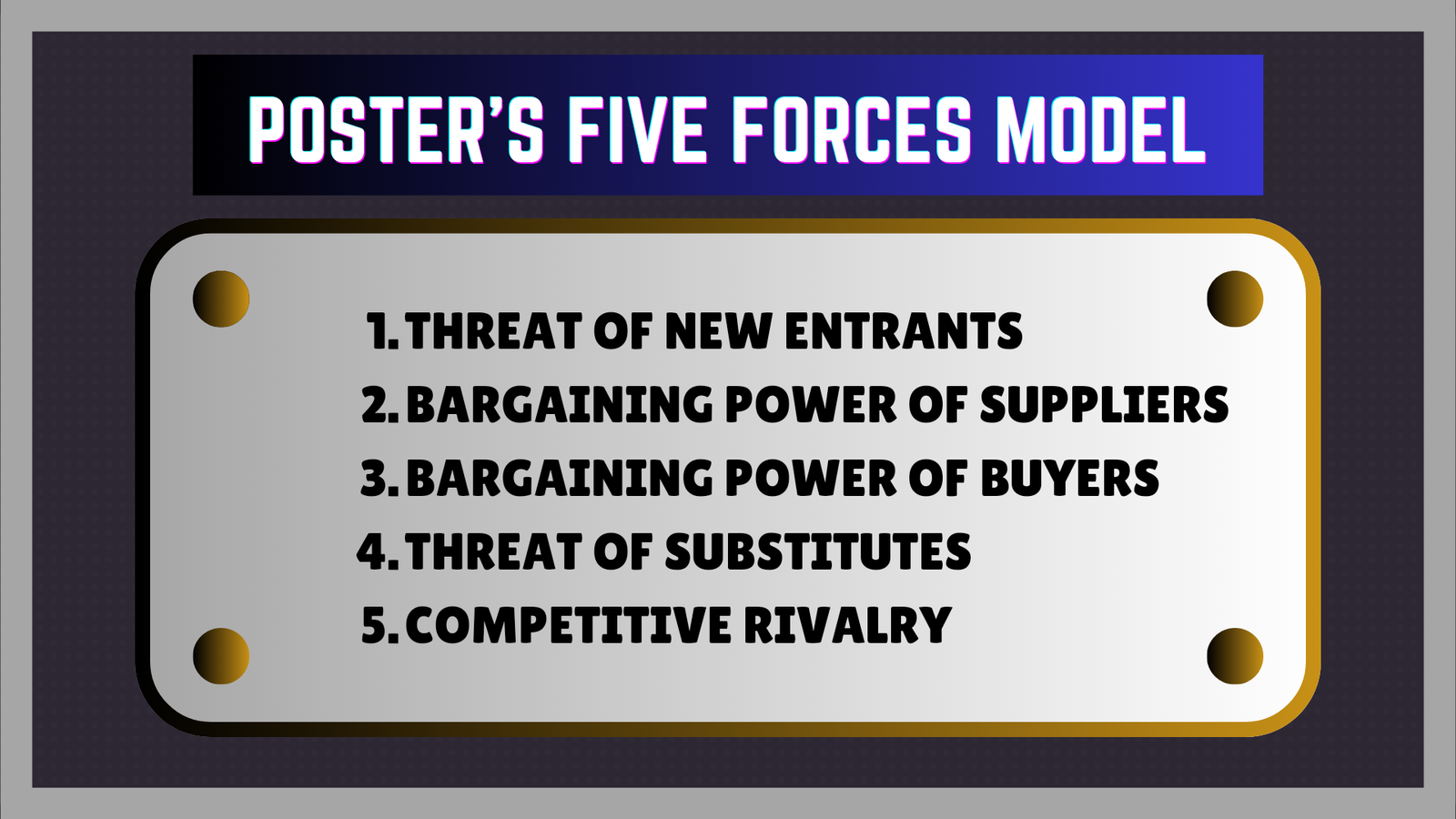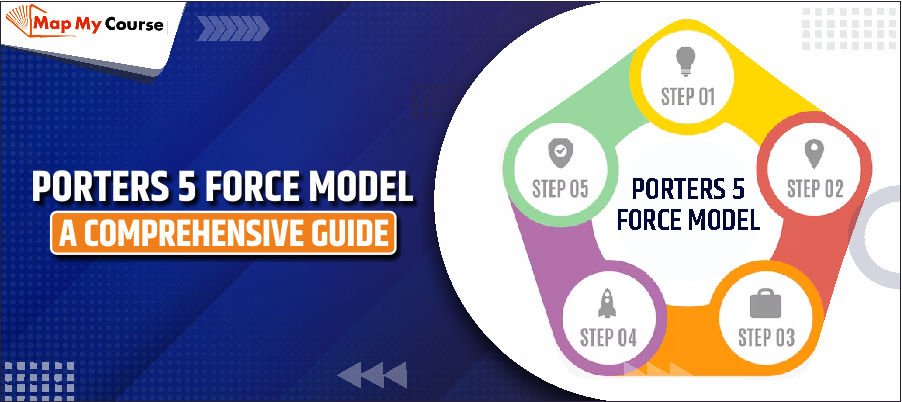Have you ever wondered why some businesses do really well while others struggle, even in the same industry? The answer often lies in how well they understand the competition around them. That’s where Porter’s 5 Forces Model comes in.
This model was created by Michael E. Porter, a famous professor from Harvard. It helps us understand the factors that affect competition in any industry. For Indian students who are studying BBA, MBA, or any commerce-related course, this model is very useful.
In this blog, we’ll explain what Porter’s 5 Forces Model is, what the 5 forces are, how to use it, and we’ll also look at an easy example so you understand it better.
What Is Porters 5 Forces Model?
The factors are the threat of new entrants, bargaining power of suppliers, bargaining power of buyers, threat of substitutes, and competitive rivalry. By considering these five forces, businesses get to know where the pressure points in the industry are and come up with more innovative strategies.
It doesn’t matter if you’re running a business or just learning about the functions of markets, understanding these forces can give you a clear vision of what drives competition and profits.
What Are The 5 Forces Of Porter’s Model?
- The threat of new entrants
- Bargaining power of suppliers
- Bargaining power of buyers
- Threat of substitutes
- Competitive rivalry
Let’s know about them one by one:

1. Threat Of New Entrants
This force looks at how easy it is for new companies to enter the market. If it’s easy for newcomers to join, e.g., in the tech industry, where startups can quickly launch new services, competition increases and profits for old companies decrease. However, new competition is less likely to emerge in industries like aerospace, where high investments and strict regulations are required.
2. Bargaining Power Of Suppliers
It talks about the power owned by suppliers in the market. Suppliers can have a lot of power if they are few or provide something essential to the business that businesses can’t replace easily. The monopoly of suppliers can raise prices or limit supply and reduce the company’s profit. On the other side, when there are many suppliers, businesses can negotiate to keep costs low.
3. Bargaining Power Of Buyers
This force talks about the influence of customers on the industry. If there are lots of options, then customers can easily switch to another competitor, they can demand lower prices or better quality. For example, in the retail or tech industry, where customers can quickly compare products online, businesses must keep prices competitive and offer great value to retain customers.
4. Threat Of Substitutes
This force analyses the market’s availability of products and services that can replace the industry offerings. If many alternatives offer similar or better value, businesses may lose customers. For example, if a cheaper or more convenient alternative can easily replace a company’s product, it faces a higher threat of substitutes, which can reduce profits.
5. Competitive Rivalry
It analyses the competition in the market between existing players. If many companies offer similar products, rivalry increases and may lead to price wars, more marketing battles, and lower profit margins. The more competitors there are, the harder it is for any single company to stand out and make good profits.
How To Apply Porter's 5 Forces Model?
- Evaluate Your Competitors: Analyze the number and strength of competitors in your market to understand the intensity of rivalry.
- Calculate Your Suppliers’ Bargaining Power: Assess how much control your suppliers have over prices and supply to determine their influence.
- Evaluate Your Buyer’s Bargaining Power: Understand how much influence your customers have over pricing and product features based on their options.
- Identify The Threat Of New Entrants: Determine how easy it is for new companies to enter your market and compete with you.
- Evaluate The Threat Of Substitution: Analyze the availability of alternative products or services that could replace what you offer, affecting customer loyalty.
What Factors Influence The Porter’s Five Forces Model?
- Industry Structure: This factor tells you about the competition and how easy it is for new players to enter. Knowing this helps you decide whether to focus on standing out with something unique or offer products or services at the best price to stay ahead.
- Power Dynamics: This factor tells you who controls the market, whether it’s your suppliers or buyers. By analysing this, you can negotiate better deals with suppliers or find ways to keep your customers loyal and happy.
- Profitability: Profitability is all about managing competition, supplier power, and substitutes. Knowing these forces lets you decide where to improve and find ways to keep your profits high, even when competition is tough.
- Availability of Substitutes: Remember, if there are lots of alternatives available to what you offer, your profit margin can decrease. To stay ahead, you need to ensure that your product or service is unique or adds enough value so customers stick to your product.
- Buyer Power: This factor analyses your customers’ control over the industry. If they have many choices, they can demand lower prices. Understanding this helps you offer better value and keep those customers returning.
- Industry Growth Rate: In a growing industry, there’s a chance for everyone to expand. But in a slow or shrinking market, competition rises, and businesses must fight harder for a smaller customer base. Keep it in mind while preparing Porter’s Five Forces Model.
- Regulatory Environment: Regulations affect business operations. By understanding them, you can make sure you’re following the law and find ways to use them to your advantage or avoid any problems.
Pros And Cons Of Porter’s Five Forces Model
| Pros | Cons |
| It helps identify key industry forces. | It doesn’t account for all factors like technological or political changes. |
| It promotes long-term thinking. | It can be too simplistic in some complex industries. |
| It is simple and easy to understand. | It assumes market forces are stable, which isn’t always the case. |
| It guides decision-making for strategic choices. | Requires constant updates, especially in fast-changing industries. |
Example Of Porter's 5 Forces Model In Action
- Competitive Rivalry: The smartphone market is highly competitive, with brands like Apple, Samsung, and Xiaomi constantly fighting for attention, driving prices down and forcing constant innovation.
- Threat of New Entrants: It’s tough for new companies to enter the market due to high costs and tech requirements. However, companies like OnePlus have continued to disrupt the market with affordable, feature-packed phones.
- Bargaining Power of Suppliers: Suppliers of key parts have strong power, but big companies like Apple and Samsung can negotiate better deals. Smaller companies, however, face higher costs.
- Bargaining Power of Buyers: With so many options available, customers have a lot of power, pushing companies to offer better deals, quality, and features to stay competitive.
- Threat of Substitutes: While alternatives like feature phones or smartwatches exist, they don’t fully replace smartphones, which remain the go-to device for most functions.
Have A Glance at it
Conclusion
Porter’s Five Forces Model is a smart way to understand how much competition is there in any industry. It helps businesses find out where the challenges are and how to deal with them.
If you’re a student or someone who wants to start a business, this model can help you think clearly and plan better. By looking at the five forces, new competitors, the power of suppliers and buyers, substitutes, and current competition, you get a full picture of the market.
In short, this model helps you make better decisions and stay strong in the market, especially in a country like India, where industries are changing fast.
Whether you own a business or are just starting to learn about competition, this model helps you make smart decisions and stay ahead in the market.
Frequently Asked Questions
Q1. What is Porter’s 5 Forces Model in simple words?
Ans: It is a model that helps us understand how much competition there is in a business. It shows what problems a company can face in the market.
Q2. Why is Porter’s model useful for students in India?
Ans: It helps students learn how businesses work and how they deal with competition. It is useful in projects, exams, and interviews.
Q3. Can small businesses also use this model?
Ans: Yes, small businesses can also use it to understand their market and make better plans.
Q4. Is Porter’s model still useful today?
Ans: Yes, it is useful. But since the market changes fast, companies should keep checking and updating their strategies.
Q5. How can I use Porter’s 5 Forces in my college project?
Ans: Choose an industry and explain each of the five forces using simple words and Indian examples. This will make your project easy to understand and interesting.


















